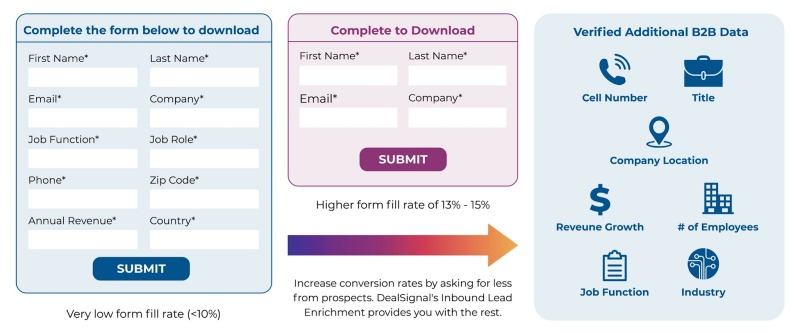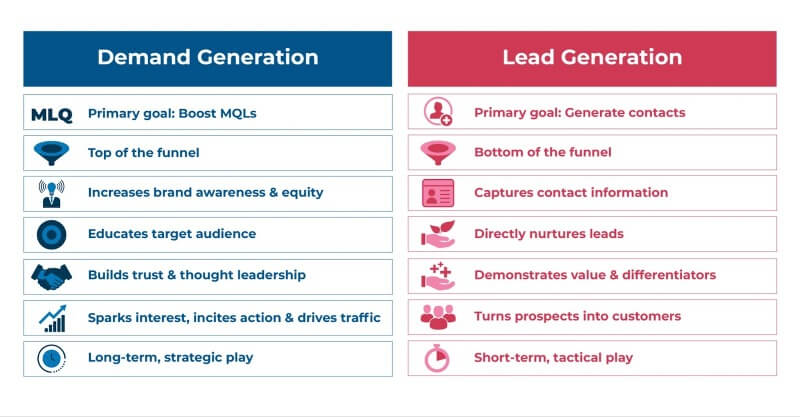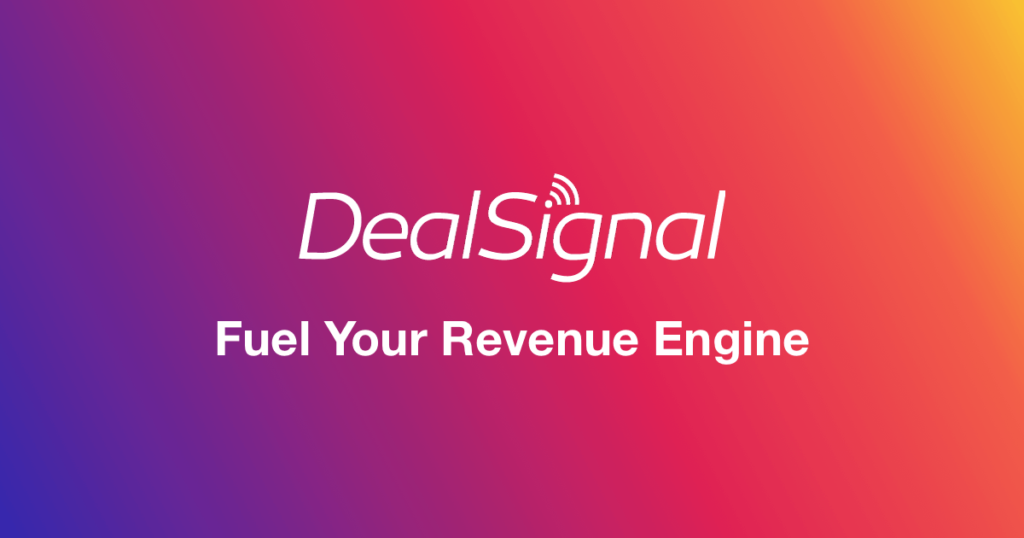- What Is Demand Generation Marketing?
- Demand Generation Strategy and Tactics
- What Is Lead Generation?
- Lead Generation Strategy and Tactics
- Demand Generation vs Lead Generation: Key Differences
- Type of Leads
- Demand Generation vs Lead Generation: Boost Results for Both
- Learn more about Demand Generation vs Lead Generation
What Is Demand Generation Marketing?
Demand generation marketing is a strategy that marketers use to generate brand awareness and interest in a product or solution at scale, leveraging several disciplines within marketing.
These disciplines can include brand storytelling, differentiated messaging and positioning, account-based marketing, content marketing, digital marketing, lead-to-revenue processes, and the tracking of key metrics for ongoing optimization.
The goal of any demand generation manager or marketing lead is to create brand awareness and interest. When interest is created, your audience is more likely to visit your website or social media, click on ads, or visit landing pages.
Demand Generation Strategy and Tactics
If you want to move prospects down the funnel, demand generation is critical. Start by reviewing B2B demand generation best practices, strategies, and tactics you should bring with you to boost your marketing-qualified leads.
Demand generation strategy
1. Boost authority with valuable content
The buying process is largely driven by independent research. Buyers today are more well-informed than ever, spending a large portion of their buyer journey researching before meeting with a sales rep. This is why creating engaging, high-value content is so critical.
Consider creating a content strategy that involves a mix of different types of content formats, like videos, blogs, webinars, and guides. You should also distribute this content on multiple channels, like email and social media.
To boost awareness, you may also want to consider partnering with other companies to extend your audience reach. For example, become a guest speaker for another company’s podcast or webinar to reach a whole new audience. Partner marketing is a great way to expand your reach and continue building your position as an industry thought leader.

2. Use intent data to find in-market buyers
Using intent data is one of the best ways to discover people who are currently in the market for a solution like yours. If you’re new to B2B intent data, it is essentially a collected set of signals that indicate a user’s interest and intent to buy a product or solution. These intent signals can be actions like the number of page clicks, the time spent on a given web page, and more.
Chances are, you are already collecting intent data. If your team has a CRM, website cookies enabled, email tracking, marketing automation, or social listening tools, you’re collecting first-party intent data and observing who is engaging most closely with your brand. This is referred to as first-party intent data.
There are, of course, limitations to first-party intent data. You can expand your total addressable market (TAM) and generate more awareness by using third-party intent data. With DealSignal’s Intent-Based Leads, you can find decision-makers at in-market accounts and get those leads delivered to you each week.
Demand gen tactics
- Use on-site retargeting to re-engage leads
- Create a blog and consistently publish
- Write thought leadership content to demonstrate expertise
- Post regularly on social media
- Create an email newsletter with valuable insights
- Get featured on guests’ blogs to extend your reach
- Host webinars or live video events
- Write case studies to attract new customers
- Create a podcast or guest speakers on relevant podcasts
- Create, free interactive digital tools on your website
- Partner with influencers to boost visibility
- Become active in relevant online forums or groups
What Is Lead Generation?
Lead generation can be defined as the act of capturing the contact data of folks raising their hand to start a conversation with your company, coupled with a timely follow-up approach toward booking a discovery meeting or product demonstration.
But, this is key: lead generation is only successful when a team’s demand generation strategy is solid. Once you have a person’s attention and interest, you are more likely to capture their contact information via a landing page, web form, or other methods.
Demand generation builds a person’s interest and brings them to your website or landing page. But now that they’re on your page, in order to get them to willingly provide contact details, you must have great lead generation content that clearly demonstrates the value of your solution and your brand’s differentiators.
While the content for demand generation tends to be more educational and trust-building, lead generation is more tactical and value-driven because, at this point, the prospect has moved further down the funnel.
Lead Generation Strategy and Tactics
Now that demand generation has done its job in creating interest and driving traffic, it’s up to lead generation marketers to push prospects further down the funnel. Below are a few lead-generation strategies and tactics to consider.
Lead generation strategies
1. Keep lead forms short
The shorter a lead form is, the more likely a person will fill it out. Many marketers struggle with the length of lead forms because there are many data points that sales reps need to do a good job—like company size, job title, industry, location, and more.
Marketers often feel like they only have two options. Option A) Create a short lead form but get criticized for providing low-quality leads that sales can’t use. Option B) Create lengthy forms with the information sales needs, but generate a much smaller amount of leads.
By using third-party B2B data platforms, like DealSignal, you can get the best of both worlds. Build a short lead form so you get the most amount of form fills, and then use DealSignal’s Inbound Lead Enrichment to fill in all of those important, missing fields for you.

2. Personalize your lead nurture campaigns
We all know that personalized content performs better than broad, generalized content. When you’re able to truly tap into a prospect’s pain points, they’re more likely to convert.
Often, marketers struggle with a big gap in data. They have some pieces of the puzzle—like email address, name, and job title—but not enough to form a whole picture. By using Inbound Lead Enrichment to fill in all of those gaps for 100+ data fields, you’re best equipped to create personalized content that converts.
Lead gen tactics
- Create enticing lead magnets, like a free webinar or ebook
- Create whitepapers to showcase solution benefits
- Develop interesting quizzes with email opt-in to obtain results
- Add dynamic CTAs to blog posts
- Provide gated offers
- Publish useful, actionable tools and resources
- Host a contest or giveaway
- Create a gated free course or webinar
Demand Generation vs Lead Generation: Key Differences
Demand generation vs lead generation – what are the main differences?
Demand generation is all about generating awareness, creating buzz, sparking interest, and attracting as many people from your target audience as possible. The end goal and ultimate success metric of demand generation marketers are increasing the amount of marketing qualified leads (MQLs).
Lead generation, on the other hand, leverages the interest that demand generation has created and works to capture contact information. At this point, the potential customer has moved further down the funnel and needs to be shown what makes this brand different and the value that the brand’s solution or product could bring into their lives. Otherwise, why would they provide an email address and invite more potential clutter into their inboxes?

Both demand generation and lead generation are equally important aspects of marketing, as both have their role in turning a person into a full-fledged customer. However, it’s important to note that without a good demand generation strategy, lead generation would struggle.
Type of Leads
Leads can be categorized into different groups based on their engagement and position in the buyer’s journey.
- Marketing qualified lead (MQL): these leads engage with your marketing materials but are still at the early stages of the sales funnel. They require lead nurturing to build interest and readiness for a sales conversation.
- Sales qualified lead (SQL): these leads show strong interest in your product or service by taking actions such as signing up for a demo or exploring pricing information. They are likely ready for direct engagement with your sales team.
- Product qualified lead (PQL): These leads have experienced your product through a free trial or a limited version of your offering. When they take actions indicating a willingness to pay for the full product, they become product-qualified leads.
Categorizing leads into these groups allows you to tailor your marketing and sales efforts accordingly, ensuring more effective lead nurturing and conversion.
Demand Generation vs Lead Generation: Boost Results for Both
Demand generation vs lead generation. They are both crucial areas of marketing that support sales and drive company revenue. One of the most overlooked—yet most advantageous—tips for driving better demand gen and lead gen results is starting with a strong foundation: good data.
In order to reach prospects and leads, you need to have fresh, accurate contact details. Otherwise, you put a lot of effort into building great content, only for a fraction of your total addressable market to actually ever see it.
Additionally, without comprehensive contact data, you will struggle to create personalized messaging that does a better and faster job of converting contacts into leads and leads into bonafide customers.
DealSignal’s platform is designed to help demand generation and lead generation marketers identify buying groups, build decision-maker lists, uncover hidden in-market buyers, and deliver actionable leads to sales. To see how it works, schedule a free demo today.

Fresh, Global Data. Dynamically Tailored to Your Needs. That‘s DealSignal.
Learn more about Demand Generation vs Lead Generation
- Lead Enrichment: How to Streamline and Get the Most Out of Your Customer Data
- B2B Demand Generation: 7 Ultimate Success Factors
- Demand Generation vs. Lead Generation: Key Differences, Strategies, and More
- What is Intent Data
- How B2B Data Quality Impacts Email Deliverability
- CRM Data: Why Data Quality and Good CRM Management Are Essential for Sales and Marketing Success
- ZoomInfo vs. DealSignal




